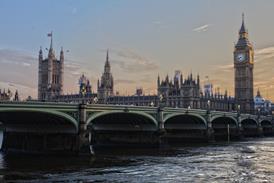Overinflated estimates of UK economic performance could strain the affordability of unfunded public sector pensions, according to new estimates, with the government forced to weigh the continued security of public sector workers’ retirement against a £150bn tax burden on future generations.
Pension schemes providing defined benefits to public sector workers including teachers, NHS workers, civil servants, firefighters and members of the armed forces, are paid directly out of the UK’s current account, unlike funded plans like the Local Government Pension Scheme.
As they do not hold assets against their liabilities, they do not present a deficit in the same way as most DB schemes. But liabilities are instead discounted by a measure linked to long-term assumptions about the growth of the UK economy, and any underperformance of this measure will lead to a theoretical shortfall needing to be plugged by greater employer contributions, cuts to future accrual or tax increases.
According to Allan Martin, an independent trustee and actuary, the optimistic assumptions implied by the Superannuation Contributions Adjusted for Past Experience, currently set at 2.4 per cent above the consumer price index, could be shown up if the UK gross domestic product continues to shrink.
Public sector employees thoroughly deserve a defined benefit pension promise; my concern is only with the calculation basis, sustainability and intergenerational fairness
Allan Martin, independent expert
He said the implications of this error have undermined the viability of public sector pensions, with generations to come footing the bill for them.
Mr Martin explained: “Estimates for the 2020 fall in GDP vary, but with a 5 per cent fall and the Whole of Government Accounts accrued liability of £1.74tn, this 2020 past service deficit implies an estimated £150bn intergenerational transfer.”
There is a lack of transparency and widespread ignorance when it comes to public sector pensions. Mr Martin pointed out: “Few people have any awareness of Scape and the discount rate. If it were used in a private sector pension scheme, the Pensions Regulator would be questioning it.”
“If you stopped someone in the street, it is a near certainty they would never have heard of it, but more importantly if you ask in the House of Commons I suspect it is a small percentage, a very small percentage of MPs, having any concept of the basis on which these promises are being made,” he said.
Mr Martin cautioned that his analysis did not necessarily suggest that public sector pensions are unaffordable, but rather that the government is not keeping an accurate measure of their cost: “Public sector employees thoroughly deserve a defined benefit pension promise; my concern is only with the calculation basis, sustainability and intergenerational fairness.”
Without further reform, the bill will be “dumped on the next generation of taxpayers”, he said.
Previous reforms bungled
Some reforms to public sector pensions have already been made following the financial crisis of 2008. The measure of inflation on which increases and revaluation were based switched to CPI from the retail price index in 2011. Future accrual across the public sector was switched to career average from final salary in 2015.
However, these changes have not been without their difficulties, with a string of legal decisions finding that they were enacted in a discriminatory manner by the government.
Test cases of the treatment of judges and firefighters, where older workers were protected from the changes, have forced the government to undo its changes – at an estimated cost of £17.9bn across the three main unfunded schemes.
Penny Cogher, partner at Irwin Mitchell, said: “These changes were successfully challenged because the government tried to ringfence the position of older workers to the detriment of younger workers – so they need to be undone, which means overall we are in a worse position than if the changes had not been made in the first place.”
Indeed, as some members may be worse off moving back to their old scheme, the government now plans to allow members to choose which benefit structure they have retrospectively applied to them.
Alex Waite, partner at LCP, said “ The most obvious way for the government to reduce the future burden of public sector pensions will be to try to reintroduce the 2015 reforms, but in a way that is not discriminatory on grounds of age, sex and race” which could cost around £4bn each year.
Mortality increase ahead
Graeme Muir, actuary and partner at Barnett Waddingham, said liability increase may be offset: “There are always bumps in the road – albeit this one is more likely to be a cavernous pothole than a bump and likely to have repercussions – not just in the short term but also in the longer term. Sadly, there will be some offsetting (positive) experience in that current mortality rates – about twice the weekly average – will reduce liabilities by more than was anticipated.”
Mr Muir concluded: “It would be a brave government who would tinker with anything in the short term, as a huge number of public sector workers have been putting their lives at risk and look likely to have their pay frozen again as we work out how to pay for all of this.”






















